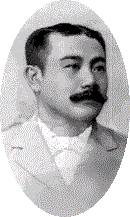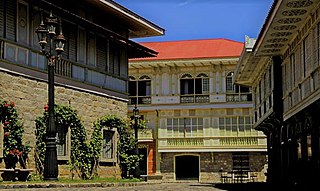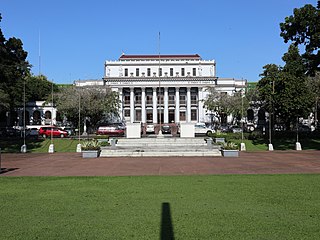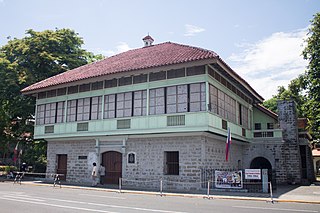
Negros Oriental, officially the Province of Negros Oriental, is a province in the Philippines located in the Negros Island Region. Its capital is the city of Dumaguete, one of the two regional centers of Negros Island Region. It occupies the southeastern half of the large island of Negros, and borders Negros Occidental, which comprises the northwestern half. It also includes Apo Island, a popular dive site for both local and foreign tourists.

Negros Occidental, officially the Province of Negros Occidental, is a province in the Philippines located in the Negros Island Region. Its capital is the city of Bacolod, of which it is geographically situated and grouped under by the Philippine Statistics Authority, but remains politically independent from the provincial government and also one of the two regional centers in Negros Island Region. It occupies the northwestern half of the large island of Negros, and borders Negros Oriental, which comprises the southeastern half. Known as the "Sugarbowl of the Philippines", Negros Occidental produces more than half the nation's sugar output.

Bacolod, officially the City of Bacolod, is a highly urbanized city in the Negros Island Region in the Philippines. With a total of 600,783 inhabitants as of the 2020 census, it is the most populous city in the Negros Island Region and the second most populous city in the entire Visayas after Cebu City.

Silay, officially the City of Silay, is a component city in the province of Negros Occidental, Philippines. According to the 2020 census, it has a population of 130,478 people.

Talisay, officially the City of Talisay, is a component city in the province of Negros Occidental, Philippines. According to the 2020 census, it has a population of 108,909 people.

Aniceto Ledesma Lacson is a Filipino revolutionary general, sugar farmer, and businessman. He is known as the first and only president of the Negros Republic from 1898 to 1901, and for leading the Negros Revolution alongside Juan Araneta.

The báhay kúbo, kubo, or payág, is a type of stilt house indigenous to the Philippines. Often serving as an icon of Philippine culture, its design heavily influenced the Spanish colonial-era bahay na bato architecture.

The architecture of the Philippines reflects the historical and cultural traditions in the country. Most prominent historic structures in the archipelago are influenced by Austronesian and American architectures.

Carlos Hilado Memorial State University, also colloquially called by its former acronym CHMSC, is a public, state-owned university, the main campus of which is in Talisay, Negros Occidental, Philippines. It provides preschool, elementary, secondary, higher technological, professional and vocational instruction and training in science, agriculture and industrial fields, as well as short-term or vocational courses.

The Balay Negrense, also known as Victor Fernandez Gaston Ancestral House, is a museum in Silay City, Negros Occidental in the Philippines, showcasing the lifestyle of a late 19th-century Negrense sugar baron. It is notable for being the first museum to be established in the province of Negros Occidental.

The State University of Northern Negros (SUNN), formerly Northern Negros State College of Science and Technology and abbreviated as NONESCOST, is a state university in Sagay, Negros Occidental, Philippines.

Ancestral houses of the Philippines or Heritage Houses are homes owned and preserved by the same family for several generations as part of the Filipino family culture. It corresponds to long tradition by Filipino people of giving reverence for ancestors and elders. Houses could be a simple house to a mansion. The most common ones are the "Bahay na Bato". Some houses of prominent families had become points of interest or museums in their community because of its cultural, architectural or historical significance. These houses that are deemed of significant importance to the Filipino culture are declared Heritage House by the National Historical Commission of the Philippines (NHCP), previously known as the National Historical Institute (NHI) of the Philippines. Preservation is of utmost importance as some ancestral houses have come into danger due to business people who buy old houses in the provinces, dismantle them then sell the parts as ancestral building materials for homeowners wishing to have the ancestral ambiance on their houses. These ancestral houses provide the current generation a look back of the country's colonial past through these old houses.

The Vega Ancestral House is one of the earliest Transition bahay na bato-inspired structures still standing, having endured through various colonial periods of the Philippines for an estimated 200 years. The house is located in Poblacion, Balingasag, Misamis Oriental.

The Hofileña Ancestral House is the residence of Manuel Severino Hofileña and his family located in Cinco de Noviembre Street, Silay, in the province of Negros Occidental, Philippines. The home was built by Hofileña for his wife Gilda Ledesma Hojilla, a former Miss Silay, and their nine children.

The Bernardino Jalandoni Museum, also known as the Bernardino Jalandoni House, located along Rizal Street, Silay City, in the province of Negros Occidental, Philippines, is the original residence of the late Don Bernardino and Doña Ysabel Jalandoni. The museum is also known as the "Pink House" because of its conspicuous pink paint that easily grabs attention.

The Negros Occidental Provincial Capitol is the seat of the provincial government of Negros Occidental located at Gatuslao St., Bacolod, Philippines. Within its complex is the Capitol Park and Lagoon.

The Mercado Mansion is a heritage house located in Carcar, Cebu, Philippines. It is a two-storey bahay-na-bato painted Mediterranean blue owned by the Mercado clan along Cebu South Road. It was declared a Heritage House by the National Historical Commission of the Philippines in 2009.

Báhay na bató, also known in Visayan languages as baláy na bató or balay nga bato, and in Spanish language as Casa de Filipina is a type of building originating during the Spanish colonial period of the Philippines. It is an updated version of the traditional bahay kubo of the Christianized lowlanders, known for its use of masonry in its construction. It uses stone and brick materials, and later synthetic concrete, rather than just organic materials of the former style. Its design has evolved, but still maintains the bahay kubo's architectural principle, which is adapted to the tropical climate, stormy season, and earthquake-prone environment of the whole archipelago of the Philippines. It fuses bahay kubo's archetecture with the influence of Spanish colonizers. It is one of the many architecture styles throughout the Spanish Empire known as Arquitectura mestiza. The style is a hybrid of Austronesian and Spanish architecture; and later, with early 20th-century American architecture, supporting the fact that the Philippines is a result of these cultures mixing. Its most common appearance features an elevated, overhanging, wooden upper story standing on wooden posts suported by a rectangular foundation. The posts are placed behind Spanish-style solid stone blocks or bricks, giving the impression of a first floor. The ground level contains storage rooms, cellars, shops, or other business-related functions. The second floor contains the living areas as it is with the bahay kubo. The roof materials are either Spanish-style curving clay tiles or thatched with leaves. Later 19th-century designs feature galvanization. Roof designs are traditionally high pitched and include gable, hip, or a traditional combination of both. Horses for carriages are housed in stables called caballerizas.

The Gabaldon School Buildings, or simply the Gabaldons, were built during the American colonial era in the Philippines. They were inspired by the bahay kubo and bahay na bato, traditional houses of the Philippines. As of about 2024, there were 2,045 Gabaldon Schoolhouses in the country.
Ricardo "Cano" Tan is a Filipino politician, businessman and former sports administrator.






















